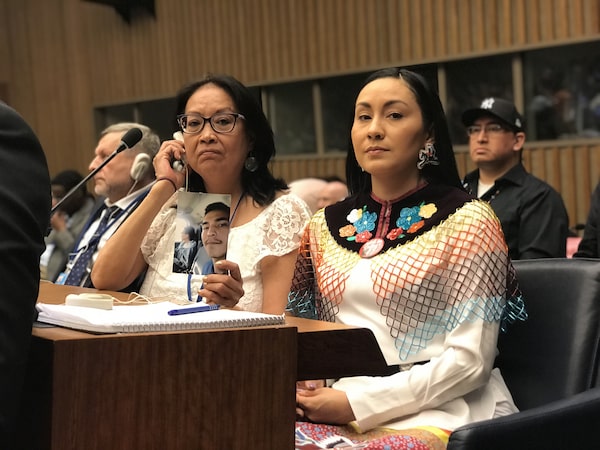For decades, provincial inquiries and royal commissions have acknowledged the unjust treatment of Indigenous people as both the victims and alleged perpetrators of crime. This year alone will bring final reports from both the inquiry into Missing and Murdered Indigenous Women and Girls, and the Viens Commission into police treatment of Indigenous women in Val d’Or, Que.
The family of Colten Boushie – the 22-year-old Cree man fatally shot by white farmer Gerald Stanley in rural Saskatchewan in 2016 – wants another. The reasons why are made clear in nipawistamasowin: We Will Stand Up, a new documentary by Tasha Hubbard.

Colten Boushie's mother Debbie Baptiste, left, and Jade Tootoosis sit in the United Nations building in this image from Tasha Hubbard's documentary nipawistamasowin: We Will Stand Up.Melissa Kent/National Film Board of Canada via The Canadian Press
Ms. Hubbard, who is also Cree from Saskatchewan, follows the family through Mr. Stanley’s trial, his eventual acquittal by an apparently all-white jury, and its efforts to push for answers. Mr. Boushie’s mother, Debbie Baptiste, reiterates how RCMP officers who came to announce her son’s death asked if she was drunk before searching her home as if she were a suspect, not a victim. The audience is reminded that officers left the car Mr. Boushie died in uncovered in the rain with the door open, allowing potential evidence to wash away.
His family is right to push for a provincial inquiry or wider-ranging federal royal commission. But over the past 30 years alone, such inquiries have produced thousands of pages of reports, the later ones noting those that came before. Some of their recommendations might have saved Mr. Boushie’s life, or at least ensured public confidence in Mr. Stanley’s trial – if not for Canada’s bad habit of studying the problem, instead of actually solving it.
In 1989, Nova Scotia’s Marshall Commission considered the wrongful murder conviction of Donald Marshall Jr., a Mi’kmaq teenager imprisoned for 11 years. The jurors were all white, as appeared to be the case in Mr. Stanley’s trial; across Canada, lawyers have the ability to reject potential jurors without cause through peremptory challenges.
Both the Marshall commission and the 1996 justice report by the Royal Commission on Aboriginal People (RCAP) criticized such racially skewed juries. In 1999, the Aboriginal Justice Inquiry of Manitoba went further, recommending that peremptory challenges be eliminated.
Yet they’re still around. In nipawistamasowin, Jody Wilson-Raybould pledges to consider the issue. Even if she intended to, the former attorney-general can’t do anything about it now.
Before jury selection, though, comes police investigations, and there have been decades worth of ideas on improving them. The RCAP advised system-wide anti-racism education for police officers, as did the 2010 Oppal Commission in British Columbia, which found that the investigation into serial killer Robert Pickton was hindered by police bias toward his poor, female, often Indigenous victims.
Such training has happened in the Ontario Provincial Police, Senator Gwen Boniface said this week. As the OPP’s former commissioner, she oversaw the force during the inquiry into the 1995 Ipperwash beach standoff, when Ojibwa man Dudley George was shot and killed by the OPP.
Ms. Boniface said anti-bias efforts, including the hiring of more First Nations officers, began even before the inquiry report came out in 2007. The OPP reports annually on the status of the Ipperwash recommendations; a promised outside evaluation, however, has yet to happen.
Even so, anti-Indigenous racism remains a problem in Ontario policing. Last fall, yet another investigation out of Thunder Bay noted that systemic racism is rife in that city’s force. Yes, that’s a separate force from the OPP; Canada has more than 140 police forces. An inquiry must not come before action in every one.
Saskatchewan has had its share. The high-profile freezing death of Cree teen Neil Stonechild was central to two – in 2000 and again in 2004 – that focused on “starlight tours,” in which police abandoned Indigenous people far from home.
And another 2004 report, from the province’s Commission on First Nations and Métis Peoples and Justice Reform, devotes a full chapter to a suggestion that’s particularly poignant when considering Mr. Boushie: anti-racist education for the community at large.
Indeed, in nipawistamasowin, Ms. Hubbard traces today’s attitudes back to the late 1800s, when Indigenous leaders were jailed or executed and their communities were forcibly moved to reserves, forbidden from leaving without a government pass. That’s when the criminalization of Indigenous movement in the Prairies began.
It’s the historical background for Mr. Stanley’s actions toward a group of Cree youth parked in his driveway, and the way he seemingly privileged his property and tools over human life.
Last week, Prime Minister Justin Trudeau posthumously exonerated Chief Poundmaker, a Cree leader wrongfully jailed for treason in 1885. The chief was, said Mr. Trudeau, “a leader who, time and again, sought to prevent further loss of life in the growing conflict in the Prairies.”
But that loss of life continues to this day – in part because inquiries are standing in place of action.